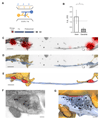Local dendritic activity sets release probability at hippocampal synapses
- PMID: 18701072
- PMCID: PMC6390949
- DOI: 10.1016/j.neuron.2008.07.006
Local dendritic activity sets release probability at hippocampal synapses
Abstract
The arrival of an action potential at a synapse triggers neurotransmitter release with a limited probability, p(r). Although p(r) is a fundamental parameter in defining synaptic efficacy, it is not uniform across all synapses, and the mechanisms by which a given synapse sets its basal release probability are unknown. By measuring p(r) at single presynaptic terminals in connected pairs of hippocampal neurons, we show that neighboring synapses on the same dendritic branch have very similar release probabilities, and p(r) is negatively correlated with the number of synapses on the branch. Increasing dendritic depolarization elicits a homeostatic decrease in p(r), and equalizing activity in the dendrite significantly reduces its variability. Our results indicate that local dendritic activity is the major determinant of basal release probability, and we suggest that this feedback regulation might be required to maintain synapses in their operational range.
Conflict of interest statement
The authors declare no competing financial interests.
Figures






References
Publication types
MeSH terms
Substances
Grants and funding
LinkOut - more resources
Full Text Sources
Other Literature Sources
Research Materials

